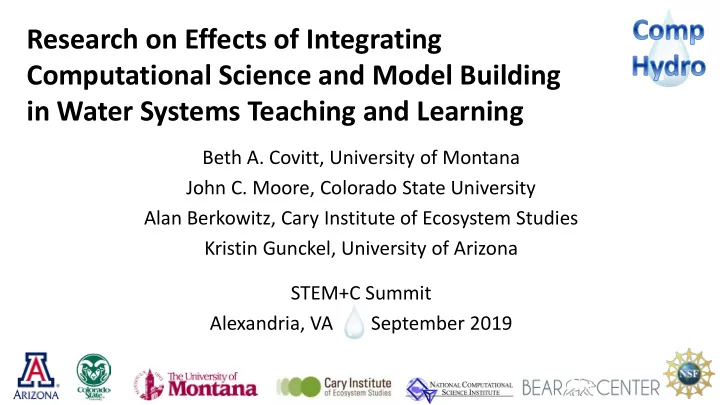

Research on Effects of Integrating Computational Science and Model Building in Water Systems Teaching and Learning Beth A. Covitt, University of Montana John C. Moore, Colorado State University Alan Berkowitz, Cary Institute of Ecosystem Studies Kristin Gunckel, University of Arizona STEM+C Summit Alexandria, VA September 2019
Integrating hydrologic systems knowledge and practice with computational thinking in authentic and innovative ways to support environmental science literacy. Model-Based Computational Understanding of Thinking Concepts & Hydrologic Systems Practices
Environmental Science Literacy Knowledge and practice needed to participate in debates and discussions of socio-environmental problems. Today, environmental science literacy requires computational thinking.
Comp Hydro Sites Montana, Univ. of Montana 4 rural, 4 urban districts Groundwater Contamination Ft. Collins, CO Colorado State Univ. 1 urban district Water Allocation Baltimore, MD Cary Institute Tucson, AZ 1 urban district Univ. of Arizona Flooding 1 urban district Groundwater Contamination
Integrated Instruction & Research Intertwined practices & disciplinary core ideas Student Performances Problem: Groundwater Using Data Surface water Computation Water Data Learning Progression Research Module Design
Hydrologic Principles Distribution of potential energy & hydraulic conductivity govern flow of groundwater & contaminants
Data Sense Making Applying scientific (hydrologic) principles in: • Connecting levels of abstraction across multiple scales • Making inferences about 3D systems from 2D representations & vice versa • Managing uncertainty in data
Computational Thinking Applying scientific (hydrologic) principles in reasoning concerning: • Abstraction (including parameterization & discretization) • Boundary conditions • Calibration & model validity judgments • Advantages & limitations of computational modeling
Learning Progression Research Questions 1. What are patterns in increasingly sophisticated ways that students think about and make sense of computational modeling of hydrologic systems? 1. Does participation in Comp Hydro support students in becoming more sophisticated in their reasoning with respect to the learning progression?
Assessment and Learning Progression Development Assessment Interpretation • Develop/revise items Analyze data and • Collect data identify patterns in students’ learning performances Model of Cognition Develop/revise LP Framework (NRC, 2006, Systems for State Science Assessment)
Assessment and Learning Progression Development Assessment Interpretation • Develop/revise items Analyze data and • Collect data identify patterns in students’ learning performances Pre, post, & embedded constructed response items elicit students’ connected knowledge & practice in: • Hydrologic systems • Data sense making Model of Cognition • Computational thinking Develop/revise LP Framework (NRC, 2006, Systems for State Science Assessment)
Upper Anchor and Assessment Items
Upper Anchor and Assessment Items
Parameter ID What info about each cell in the grid would be needed to compute and predict flow of water and MTBE through the system? Explain why each type of info (parameter) you listed is important.
Analysis 1. Work with sets of item responses 2. Identify patterns of indicators in responses 3. Group indicators into proposed LP levels 4. Iterations of coding, interrater reliability, and refinement 5. Sets of coded data subjected to IRT analysis a. Wright maps b. Learning evidence Three learning progression levels emerged that are consistent across the progress variables.
CT for Hydrologic Systems Modeling Learning Progression* *Upper anchor represents environmental science literacy for participating in debates and discussions – a social participation goal.
How can a scientist judge if a computer model is accurate?
How can a scientist judge if a computer model is accurate?
How can a scientist judge if a computer model is accurate?
Learning Evidence • Evidence below: 91 MT students, “explaining & predicted w/models” items • Currently working on analysis with 1400 MT and AZ students w/all progress variables Wright Map Latent regression w/fixed pre/post dummy variable • Green graph: distribution of student proficiency • Beta = 0.93, s.e. = 0.11, p < .001 scores • Purple triangles: difficulty thresholds for LP • Students’ post mean ability (pink) higher than pre (blue) levels for each item
Research Products Past Conference Products (and in preparation for publication submission) Available on website: • Students Ideas about Computational Thinking Concepts When Learning to Model Contact Info Hydrologic Systems , Gunckel High School Students’ Developing Ideas about Computational Modeling of Earth • and Environmental Systems , Podrasky Website • Teacher Perspectives of Teaching Computational Thinking , Cooper • High School Students’ Sense Making with Contour Maps When Learning to Model www.ibis.colostate.edu/comph Hydrologic Systems, Covitt ydro/ Student Empowerment in an Environmental Science Literacy Unit about • Groundwater Contamination , Moreno In preparation for NARST and publication submission Beth Covitt • Developing and Validating a Learning Progression for Computational Thinking in Earth and Environmental Systems , Covitt beth.covitt@umontana.edu • Intertwining Three Dimensions: Levels of Performance for Computational Thinking While Using Models of Hydrologic Systems , Gunckel This research is supported by a grant from the National Science Foundation: Research on Effects of Integrating Computational Science and Model Building on Water Systems Teaching and Learning (DRL 1543228). Any opinions, findings, and conclusions or recommendations expressed in this material are those of the author(s) and do not necessarily reflect the views of the National Science Foundation, the United States Department of Energy, or the United States Department of Agriculture.
Recommend
More recommend